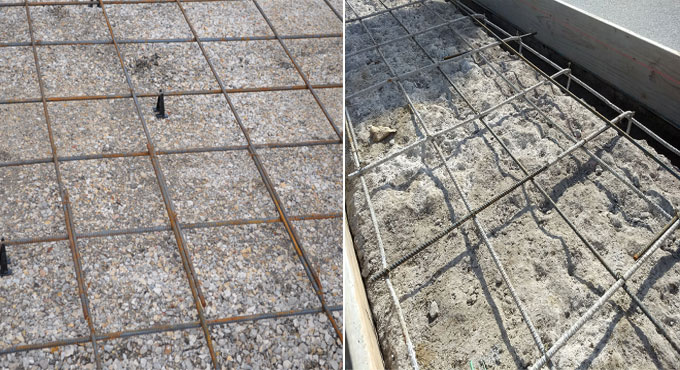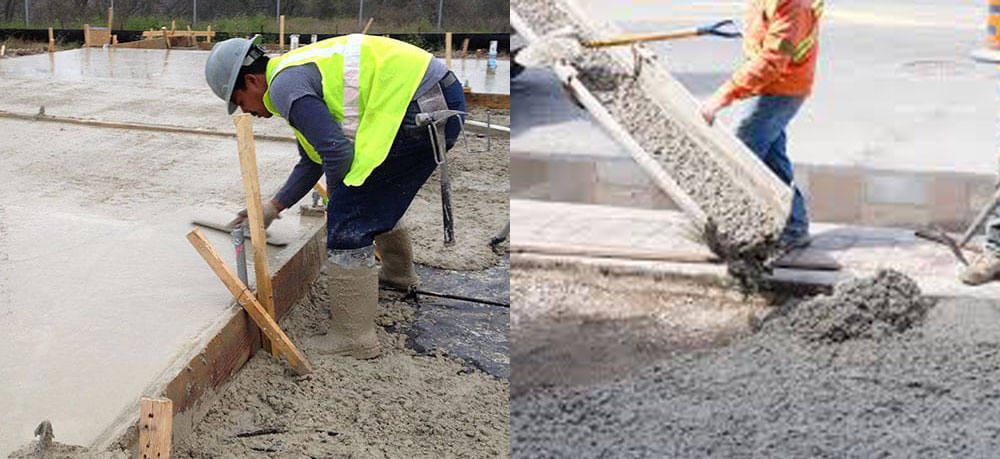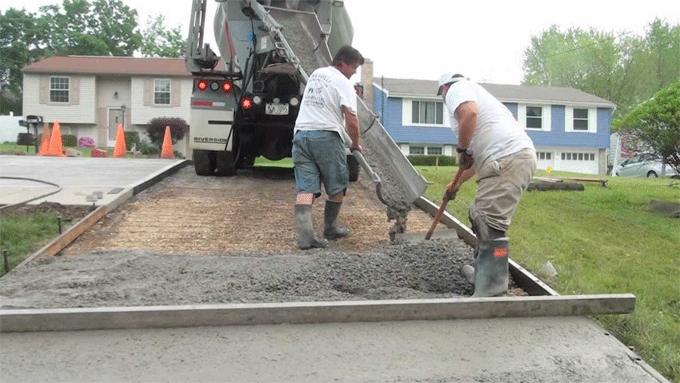A concrete driveway should be strong enough to provide support to the cars and trucks which may drive over it. The concrete driveway should be constructed in such a manner so that the longevity of your house is enhanced.
Normally, the thickness of concrete driveway slabs remain 4 inches but the thickness can be 6 inches to give extra support for large trucks and other heavy vehicle traffic.
Preferably, the slab contains some type of reinforcement inside. One common building reinforcement material is rebar.
Rebar: Rebar is built up with steel and has been employed for more than 150 years to reinforce concrete construction. Concrete slabs are extremely susceptible to cracking, and rebar facilitates to control cracks from being expanded since sections of cracked slabs move apart.
Rebar verses Mesh: Welded wire mesh is a good substitute to rebar for driveway reinforcement. The mesh comprises of galvanized panels of welded wire. Heavy gauge welded wire mesh panels arrange reinforcement for driveways which are not regularly steered with heavy vehicles like construction vehicles or industrial trucks.
Mesh is generally applied by the contractors who pour 4 inches thick driveway concrete as it is a finer reinforcement and not very costly as compared to rebar.
To pour in a thicker driveway, number three rebar should be applied, that is 3/8 inches in diameter, for reinforcement.
Applying Rebar: Rebar will be very effective in a driveway for which 5-6 inches of concrete is poured. It is due to rebar is relatively thicker as compared to galvanized mesh reinforcement. In order to apply rebar reinforcement in a perfect way, make sure that it is placed in the center or marginally over the center of the slab's thickness.
For this purpose, concrete pros hold up the rebar grids on special metal or plastic supports, known as "chairs." The bricks and other scrap material can also be employed for supports, but it can produce weak spots in the slab. Rebar grids are built up by placing the pieces of bar in a perpendicular pattern, with equal span.
The bars are secured jointly at each intersection through metal wire. The edges of the grid should be retained at same gaps from all sides of the slab, and the minimum coverage of concrete should be retained all through the slab.

Read Continue
~~~~~~~~~~~~~~~~~~~~~~~~
Published By
Rajib Dey
www.constructioncost.co
~~~~~~~~~~~~~~~~~~~~~~~~
Normally, the thickness of concrete driveway slabs remain 4 inches but the thickness can be 6 inches to give extra support for large trucks and other heavy vehicle traffic.
Preferably, the slab contains some type of reinforcement inside. One common building reinforcement material is rebar.
Rebar: Rebar is built up with steel and has been employed for more than 150 years to reinforce concrete construction. Concrete slabs are extremely susceptible to cracking, and rebar facilitates to control cracks from being expanded since sections of cracked slabs move apart.
Rebar verses Mesh: Welded wire mesh is a good substitute to rebar for driveway reinforcement. The mesh comprises of galvanized panels of welded wire. Heavy gauge welded wire mesh panels arrange reinforcement for driveways which are not regularly steered with heavy vehicles like construction vehicles or industrial trucks.
Mesh is generally applied by the contractors who pour 4 inches thick driveway concrete as it is a finer reinforcement and not very costly as compared to rebar.
To pour in a thicker driveway, number three rebar should be applied, that is 3/8 inches in diameter, for reinforcement.
Applying Rebar: Rebar will be very effective in a driveway for which 5-6 inches of concrete is poured. It is due to rebar is relatively thicker as compared to galvanized mesh reinforcement. In order to apply rebar reinforcement in a perfect way, make sure that it is placed in the center or marginally over the center of the slab's thickness.
For this purpose, concrete pros hold up the rebar grids on special metal or plastic supports, known as "chairs." The bricks and other scrap material can also be employed for supports, but it can produce weak spots in the slab. Rebar grids are built up by placing the pieces of bar in a perpendicular pattern, with equal span.
The bars are secured jointly at each intersection through metal wire. The edges of the grid should be retained at same gaps from all sides of the slab, and the minimum coverage of concrete should be retained all through the slab.

Read Continue
~~~~~~~~~~~~~~~~~~~~~~~~
Published By
Rajib Dey
www.constructioncost.co
~~~~~~~~~~~~~~~~~~~~~~~~


